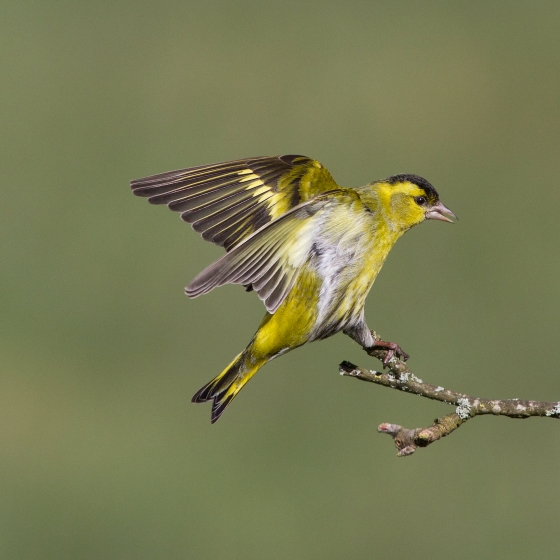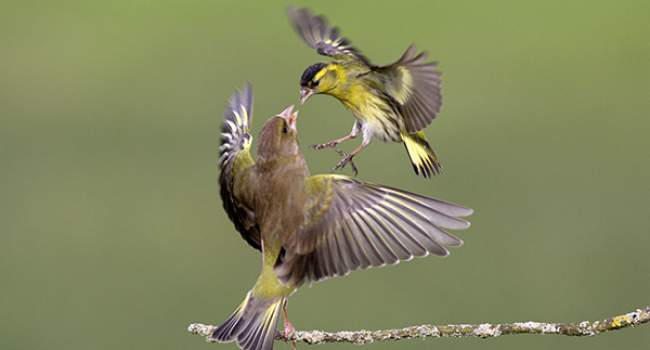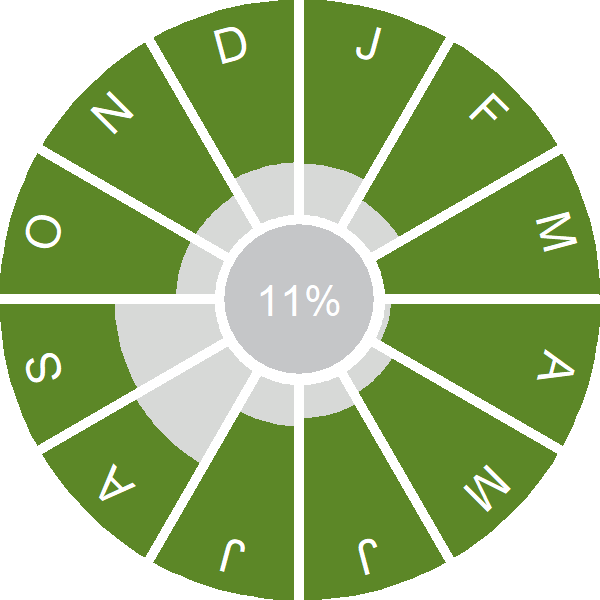Siskin
Spinus spinus (Linnaeus, 1758)
SK
 SISKI
SISKI  16540
16540

Family: Passeriformes > Fringillidae

This acrobatic little finch is very much a bird of our pine forests, where its bright yellow rump glows against the dark trees.
Yellow-green with black streaks, the Siskin specialises in feeding on tree seed with those from pine trees particularly favoured, along with Alder and birch. When seeds in the wider countryside begin to run out, Siskins turn to gardens and can be seen feeding alongside some of our more familiar garden birds on our hanging feeders.
The Siskin breeds throughout Britain & Ireland, although it is less commonly found in central and eastern England than in other areas. In winter, Siskins can be found almost anywhere in Britain & Ireland, with breeding populations supplemented by arrivals from elsewhere in Europe.
Exploring the trends for Siskin
Our Trends Explorer will also give you the latest insight into how the UK's Siskin population is changing.
trends explorerIdentification
Siskin identification is often straightforward. The following article may help when identifying Siskin.
Identifying Green finches in your garden

Not all green finches are Greenfinches. There are a number of green and yellow finches that visit garden feeders, some common, some much more rare. Let us help you to discover the identity of an unfamiliar visitor - is it a Serin - or is it one of the more likely culprits?
SONGS AND CALLS
Listen to example recordings of the main vocalisations of Siskin, provided by xeno-canto contributors.
Flight call
Call
Song
Develop your bird ID skills with our training courses
Our interactive online courses are a great way to develop your bird identification skills, whether you're new to the hobby or a competent birder looking to hone your abilities.
Browse training coursesStatus and Trends
Population size and trends and patterns of distribution based on BTO surveys and atlases with data collected by BTO volunteers.
CONSERVATION STATUS
This species can be found on the following statutory and conservation listings and schedules.
POPULATION CHANGE
The 1988-91 Breeding Atlas identified a major expansion of the breeding range into southern Britain (Gibbons et al. 1993) and subsequently there have been further considerable range gains, especially in the south and west (Balmer et al. 2013). Progressively more CBC plots became occupied during the 1970s and 1980s (Marchant et al. 1990), but samples were insufficient for annual monitoring until BBS began in 1994. Results since then show parallel fluctuations of extraordinary amplitude in England and Scotland. To some extent, this may reflect the occasional large continental influxes affecting spring numbers on a broad UK scale. There has been a decline across Europe since 1980 (PECBMS: PECBMS 2020a>).
| UK breeding population |
+35% increase (1995–2022) 
|
Exploring the trends for Siskin
Our Trends Explorer will also give you the latest insight into how the UK's Siskin population is changing.
trends explorerDISTRIBUTION
Siskins are strongly associated with landscapes dominated by conifer plantations, particularly on moors, low hills and the lower slopes of the uplands. Accordingly breeding Siskins are found through most of Scotland and Wales and much of northern and southwest England, with a patchier distribution elsewhere. In Ireland they are more widespread in the western half of the country, with more-isolated pockets in the east and south.
Occupied 10-km squares in UK
| No. occupied in breeding season | 1875 |
| % occupied in breeding season | 62 |
| No. occupied in winter | 2598 |
| % occupied in winter | 86 |
European Distribution Map
European Breeding Bird Atlas 2
Breeding Season Habitats
| Most frequent in |
Coniferous Wood 
|
Relative frequency by habitat
Relative occurrence in different habitat types during the breeding season.

DISTRIBUTION CHANGE
Since the 1968–72 Breeding Atlas there has been a 166% range expansion, including gains in Wales, southern and southwestern England and large parts of Ireland. In Scotland, birds have spread into the northeast and onto the Northern Isles and Outer Hebrides. Abundance has also increased since the 1988–91 Breeding Atlas throughout Wales, Scotland and the western half of Ireland.
Change in occupied 10-km squares in the UK
| % change in range in breeding season (1968–72 to 2008–11) | +167.5% |
| % change in range in winter (1981–84 to 2007–11) | +45.8% |
SEASONALITY
Siskin is recorded throughout the year.

Movement
Information about movement and migration based on online bird portals (e.g. BirdTrack), Ringing schemes and tracking studies.
An overview of year-round movements for the whole of Europe can be seen on the EuroBirdPortal viewer.
RINGING RECOVERIES
View a summary of recoveries in the Online Ringing Report.
Foreign locations of birds ringed or recovered in Britain & Ireland

Biology
Lifecycle and body size information about Siskin, including statistics on nesting, eggs and lifespan based on BTO ringing and nest recording data.
PRODUCTIVITY & NESTING
Number of Broods 
|
2 |
Egg Size 
|
16×12 mm Weight = 1.3 g (of which 5% is shell) |
Exploring the trends for Siskin
Our Trends Explorer will also give you the latest insight into how the UK's Siskin population is changing.
trends explorerSURVIVAL & LONGEVITY
View number ringed each year in the Online Ringing Report
Exploring the trends for Siskin
Our Trends Explorer will also give you the latest insight into how the UK's Siskin population is changing.
trends explorerBIOMETRICS
Wing Length 
|
Adults | 72.6±3.5 | Range 70–76mm, N=60879 |
| Juveniles | 72.2±1.9 | Range 69-75mm, N=3637 | |
| Males | 73.5±1.7 | Range 71–76mm, N=34720 | |
| Females | 71.5±4.7 | Range 69–74mm, N=26091 |
Body Weight 
|
Adults | 12.9±1.5 | Range 11.4–14.9g, N=51674 |
| Juveniles | 12.3±1.1 | Range 10.6–14.1g, N=3107 | |
| Males | 13.0±1.6 | Range 11.5–15.0g, N=29236 | |
| Females | 12.8±1.4 | Range 11.3–14.6g, N=22380 |
Feather measurements and photos on featherbase 
CODES & CLASSIFICATION
Ring size 
|
A |
Field Codes 
|
2-letter: SK | 5-letter code: SISKI | Euring: 16540 |
For information in another language (where available) click on a linked name
Research
Interpretation and scientific publications about Siskin from BTO scientists.
CAUSES AND SOLUTIONS
Causes of change
The main drivers of change for Siskin are uncertain. However increases in the availability of breeding habitat or the availability of winter food resources, or both, may have driven population increases.
Further information on causes of change
The maturing of new conifer plantations has aided the spread of breeding Siskins throughout the UK, from their previous stronghold in the Scottish Highlands, since about 1950. Their habit of using garden feeders, especially in late winter, has developed since the 1960s and, despite many winter birds in gardens migrating to the Baltic region to breed, may also have helped to boost the UK breeding population.
Information about conservation actions
The drivers of change for this species are unclear and therefore potential conservation actions to support this species are also unknown. The continued provision of garden bird food may help boost winter survival for UK (and also European) breeding populations, and rotational management of conifer plantations may help ensure breeding habitat continues to be available, but further research is required in order to define the habitat and food requirements for this species more precisely and hence identify specific conservation actions for both seasons.
PUBLICATIONS (1)
Do Siskins have friends? An analysis of movements of Siskins in groups based on EURING recoveries
Links to more studies from ConservationEvidence.com
Would you like to search for another species?













Share this page